To remove tar stains from shoes and clothing, start by hardening the tar with ice or dry ice for easier scraping. Gently scrape with a plastic or metal scraper. Next, apply rubbing alcohol, WD-40, or a commercial tar remover to soften the leftover residue. For sensitive materials, olive oil works well. After treatment, wash the items with heavy-duty detergent. Check for remaining stains before drying, as heat can set them. There’s more to learn about effective methods!
Key Takeaways
- Use ice cubes to harden tar on shoes or clothing before gently scraping it off with a plastic or metal scraper.
- Apply rubbing alcohol or a commercial tar remover to dissolve remaining tar stains effectively.
- For sensitive materials, use olive oil to soften the tar, letting it sit for about an hour before gently rubbing.
- After scraping, wash shoes or clothing with heavy-duty detergent and check for stains before drying to prevent setting.
- Air dry items and apply protective sprays regularly to maintain their condition and prevent future stains.
Preparation and Safety Measures
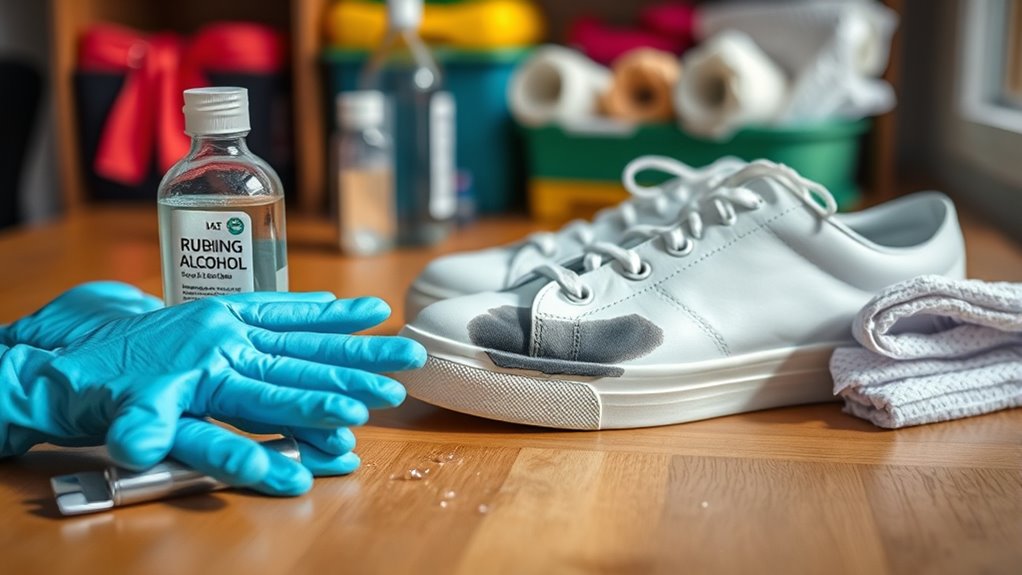
Before you tackle those stubborn tar stains, it’s essential to prepare adequately and secure your safety. Start by gathering cleaning supplies like dish soap, rubbing alcohol, or specialized tar removers. Keep clean cloths or paper towels handy for applying solvents and wiping away tar. You’ll also need plastic or metal scrapers for gently removing the substance. Don’t forget to have water nearby for rinsing afterward.
Wear protective gloves to shield your hands from harsh chemicals, and make certain you’re in a well-ventilated area to avoid inhaling fumes. Quick action is crucial; keeping children and pets away from your workspace, and have a fire extinguisher close by. By taking these precautions, you’ll set yourself up for a successful and safe cleanup.
Hardening Tar for Easier Removal
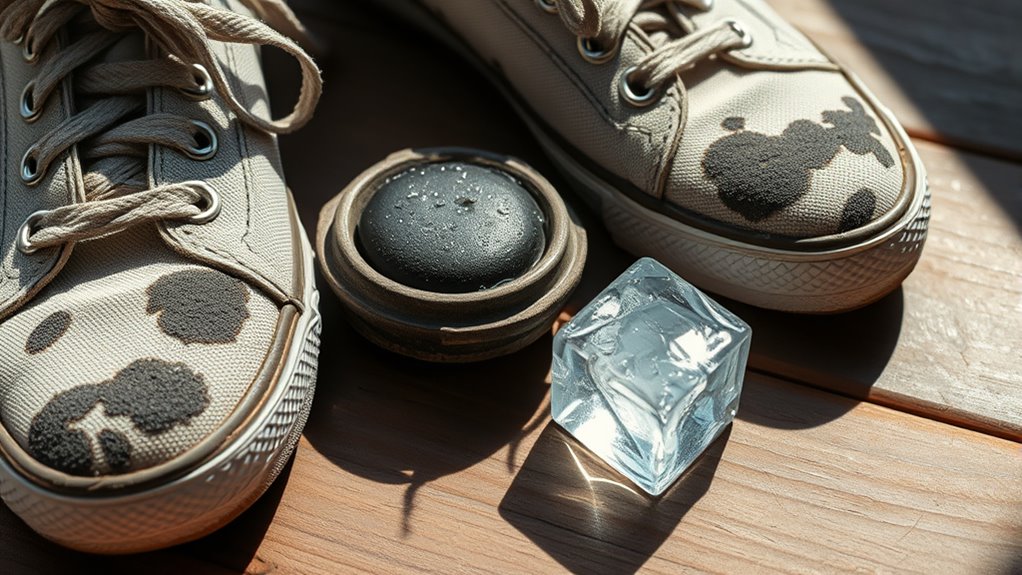
Once you’ve set up your workspace and gathered your supplies, hardening the tar can make the removal process much easier. You can use ice cubes or dry ice to cool the tar effectively. If you prefer, simply place your shoes in a cool area for about 15-20 minutes. Another option is to wrap ice cubes in a cloth and apply it directly to the tar. Once the tar hardens, grab a plastic or metal scraper to gently remove it. Be cautious not to apply too much pressure to avoid damaging your shoes. Choose a scraper that suits your material, like a credit card or a putty knife, and then proceed to scrape off the hardened tar carefully. This method is similar to using a professional grade tar and iron remover for effective cleaning, as both processes aim to make tar removal easier.
Effective Solvents for Tar Removal
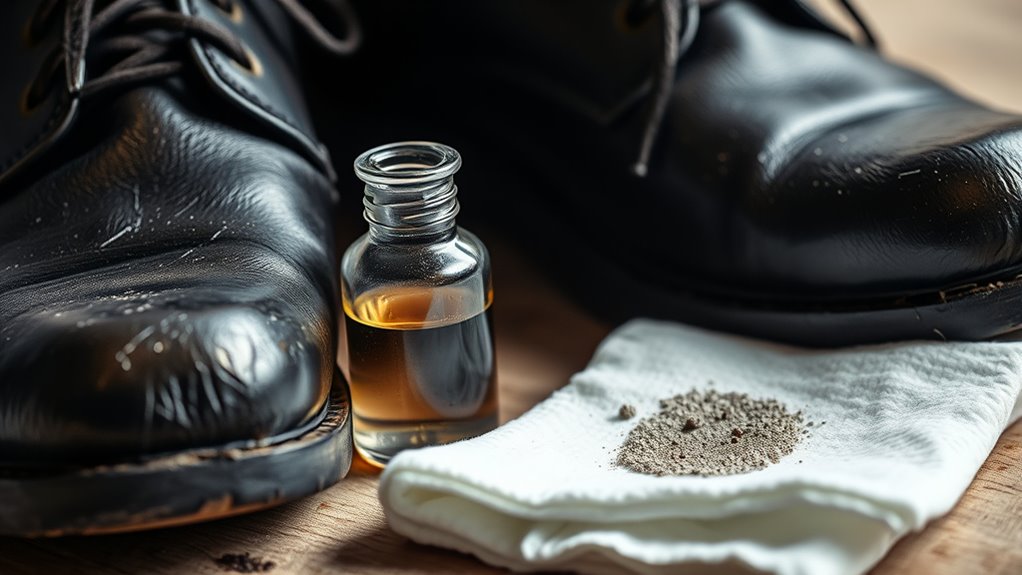
When tackling tar stains, selecting the right solvent can make all the difference in achieving a clean result.
For shoes, rubbing alcohol works wonders due to its solvent properties. WD-40 is another versatile option that effectively softens and removes tar from various surfaces. If you prefer specialized products, commercial tar removers found at hardware stores are designed for efficient removal. Nail polish remover, or acetone, can dissolve tar but use it cautiously on delicate materials. For tough stains, consider 3M Tar and Grease Remover, which excels in automotive applications. Always remember to test your chosen solvent on an inconspicuous area first to guarantee it won’t damage the surface you’re cleaning. Additionally, Tar Rid Asphalt & Tar Remover is a fast-acting solution that is specifically designed for cleaning and surface preparation without damaging surfaces.
Gentle Oils for Sensitive Materials
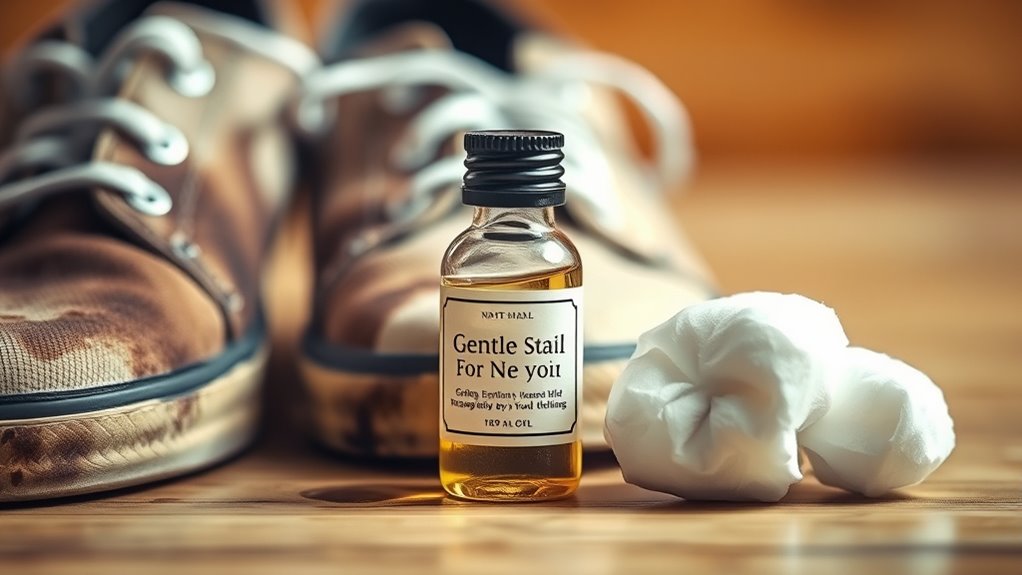
How can you safely remove tar from sensitive materials without causing damage?
Gentle oils like olive oil are ideal for this task. They’re derived from natural sources, making them safe for both your skin and the materials you’re treating. Olive oil not only softens tar but is also great for fabrics that might react poorly to harsh chemicals. Simply apply it directly to the stain and let it sit for about an hour. Additionally, using a product like Oil Slick Beach Tar Remover can provide an effective alternative for removing tar without the harsh chemicals found in traditional solvents. Afterward, use a soft cloth to gently rub away the tar. Remember to spot test first to verify compatibility, and always blot off any excess oil to prevent new stains. These gentle oils are effective and environmentally friendly, making them a smart choice for sensitive items.
Washing and Post-Cleaning Care Tips
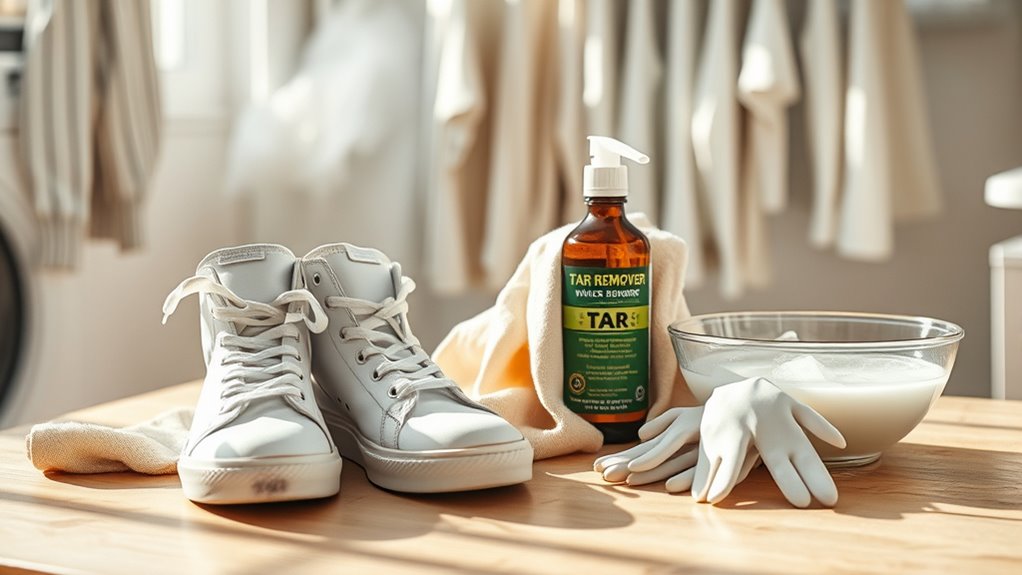
After using gentle oils to treat tar stains on sensitive materials, the next step involves proper washing and post-cleaning care.
For shoes, start by applying ice to harden the tar, then use dish soap and warm water for fabric or canvas types. If the stain persists, try rubbing alcohol or a tar-specific remover. Additionally, consider signing up for member exclusives to access helpful articles on maintaining your footwear.
For clothing, apply ice before scraping off the tar, then use heavy-duty detergent and hot water for washing. Always check for remaining stains before drying, as heat can set them.
Allow your shoes and clothes to air dry, avoiding harsh chemicals. Regular conditioning and protective sprays can help maintain your items, ensuring they stay in great shape.
Frequently Asked Questions
Can I Use Vinegar to Remove Tar Stains From Shoes?
You might be tempted to use vinegar for removing tar stains, but it’s not the best option.
While vinegar can tackle some stains, it doesn’t effectively break down tar’s sticky nature.
Instead, try using ice to harden the tar before scraping it off or opt for solvents like rubbing alcohol.
Always test any cleaner on a hidden area first to verify it doesn’t damage your shoes.
What Types of Fabrics Are Most Difficult to Clean From Tar?
Ever wondered which fabrics make cleaning tar a real challenge?
Suede and absorbent materials are tricky because they can easily be damaged by solvents.
Waxed cotton requires extra care, as it might lose its water resistance after cleaning.
Delicate leathers can discolor, and some synthetic fibers absorb tar deeply, complicating removal.
It’s essential to know your fabric before attempting any cleaning method; otherwise, you could make the stain worse.
How Can I Prevent Future Tar Stains on My Clothing?
To prevent future tar stains on your clothing, act proactively.
Start by applying stain repellents to garments that might encounter tar. Choose materials like nylon or polyester, which are easier to clean.
Regularly check for potential tar exposure and avoid delicate fabrics in risky environments.
You can also invest in tar-resistant coatings for frequently worn items, making it easier to maintain your wardrobe and keep those pesky stains at bay.
Is It Safe to Use a Hairdryer to Heat Tar Stains?
Is it really a good idea to use a hairdryer on tar stains? It’s not safe.
Direct heat can melt the tar, making it spread deeper into the fabric and causing damage. You might also release harmful fumes and create a fire hazard.
Instead, consider freezing the stain or using solvents specifically designed for removal. These methods are safer and more effective, giving you better results without risking your fabric or safety.
What Should I Do if the Tar Stain Reappears After Cleaning?
If the stain reappears after cleaning, don’t panic.
You should repeat the cleaning process with more intensity or try different solvents. Start by using a combination of products, like dish soap and rubbing alcohol, and always pretest on a small area first.
If the stain persists despite your efforts, it might be time to consult a professional cleaner who can provide specialized treatment for stubborn stains.
Conclusion
Removing tar stains can feel like a challenging task, but with the right techniques, it’s as manageable as peeling an orange. Remember to take safety precautions and choose the right method for your materials. Whether you’re using solvents or gentle oils, patience is key. Once the stains are gone, give your items a thorough wash to refresh them. With these steps, you’ll have your shoes and clothing looking good as new in no time!









